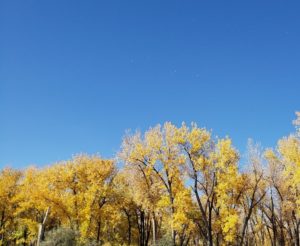
After reading about historical river geomorphology, floating the Bighorn River, and generally paying attention to how our society functions, I have realized that we like our rivers like we like our people: straight. We construct enormous dams and place levees so that rivers like the Bighorn will no longer meander, increasing linear channelization and ignoring natural flood regimes. We also teach children a strict binary for gender and that heterosexuality is the only way to love; the LGBTQ+ panic defense is even still legal right here in Montana. A desire for simple narratives of both river ecology and sexuality ignores ecological precedents and creates destruction at the expense of beauty and diversity.
While in my tent one night on the river, I was reminded that many geese are queer. The air was frigid and the cacophony of honking geese transported me back to an article titled “How to Queer Ecology: One Goose at a Time.” Using the lens that the article provided, I sought to recognize how gay nature really is. I wanted to see diversity of life and experience and recognize that the narrow window I had been given growing up simply wasn’t adequate.
I began to rethink the Bighorn River. It wasn’t solely a collection of dams separating the glistening snow-covered mountains from the historical floodplains of the valley below. This river was, and continues to be, intensely shaped by people who desire straightforward water use at the expense of a thriving ecosystem. I also ruminated on those who recreate here. While the plethora of male fishermen decked out in camo seem to be the imagined antithesis of an urban, colorful queer life, I’m reminded that I must see beyond the blinders that have been placed in front of my eyes and recognize once again that queerness may have just been forced into hiding.
I look a little further, at this point taking a step back in time. While the river is largely managed by Fish, Wildlife & Parks, above the bank is Crow (Apsáalooke) land. Crow culture included sexual or gender variance long before the onset of colonization. There was a belief that Two-Spirit (a contemporary pan-Indigenous term to recognize the intersections of queerness and Indigeneity) Crow were “lucky in love,” a quality they were able to share to others as well. The Crow even had a recognized queer cultural icon named Osh-Tisch who was “badé” and lived during the late 1800s. Although LGBTQIA2S+ people have been entangled in this landscape for far longer than the state has even existed, statewide discrimination protection based on sexual orientation or gender identity is still largely absent in Montana.
Beyond culture, I found myself mesmerized by this area that is teeming with abundance, performance, and difference. From the illustrious bald eagles to the curious killdeer and mohawked mergansers, I saw a wide range of flight patterns, colorations, behavior, and more. Just consider the enigmatic sandhill crane and their mating dances that a fellow student characterized as “exuberant.” As many of the bald and golden eagles flew from cottonwood to glistening cottonwood, I spent some time in my kayak admiring the beauty of the trees. Their figures began to blur in my mind, their elongated branches reaching towards the sunlight and their own individuality. Outstretched and beautifully contorted forks in the wide bark were reminiscent of Indya Moore or Dominique Jackson voguing in the transcendent series POSE, a story that follows New York’s ball culture that was pioneered by queer communities of color. There’s myriad queer expressions all around me, from glamorous cottonwoods to flamboyant fowl.
But my purpose here is not merely to anthropomorphize. While I could spend some time finding ecological decrees for queerness in discussing bisexual foxes or the multiplicitous sexualities of fungi, I instead want to show that there is beauty in difference. I aimed to show how plants that depended on historical flood regimes in now channeled and dammed waterways and queer youth in homophobic communities have both suffered from environments that do not support them, but have managed to survive gracefully despite. Like flowers springing up through bland concrete, queerness finds a way to endure and does so in vibrant performance.
I pause for a moment to return mentally to the ubiquitous honking geese and thank them for their powerful reminder: queerness is all around us, to see it we just need to open our hearts.
William Roddy is a student at UC Berkeley where he studies Human Geography, Applied Linguistics, and Portuguese. He enjoys being a tour guide for his university, hiking, discovering new places, and reading some good social theory.